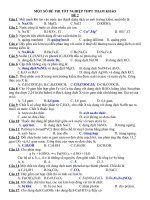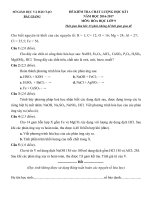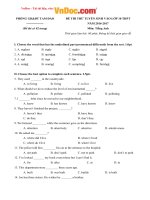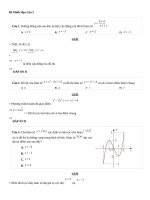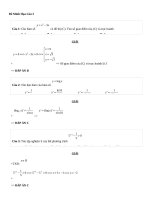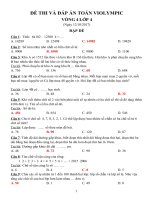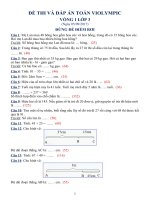đề thi đề xuất duyên hải tiếng anh khối 10 có đáp án
Bạn đang xem bản rút gọn của tài liệu. Xem và tải ngay bản đầy đủ của tài liệu tại đây (177.62 KB, 15 trang )
HỘI CÁC TRƯỜNG THPT CHUYÊN
KÌ THI HỌC SINH GIỎI
VÙNG DUYÊN HẢI VÀ ĐỒNG BẰNG BẮC
BỘ
NĂM HỌC 2017-2018
MÔN THI: TIẾNG ANH LỚP 10
Ngày thi: ……..
TRƯỜNG THPT CHUYÊN BẮC GIANG
Thời gian làm bài: 180 phút
(không kể thời gian giao đề)
ĐỀ THI ĐỀ XUẤT
(Đề thi gồm 10 trang)
A. SECTION I: LISTENING (50 points)
HƯỚNG DẪN PHẦN THI NGHE HIỂU
•
•
•
Bài nghe gồm 4 phần, mỗi phần được nghe 2 lần.
Mở đầu và kết thúc phần nghe có tín hiệu nhạc.
Mọi hướng dẫn cho thí sinh (bằng tiếng Anh) đã có trong bài nghe.
Part 1: For questions 1 – 5, listen to part of a discussion about a book on laughter. Write NO MORE
THAN THREE WORDS AND/OR A NUMBER taken from the recording for each answer in the
spaces provided. (10 points)
1. Provine’s book proposes that laughter is used to improve human ________________________ .
2. Mark says that today people often only laugh at TV ________________________ .
3. Diana says that women think a good ________________________ is vital in personal male/female
relationships.
4. Diana thinks that the fact that there haven’t been many ________________________ in the past
reflects a commonly held attitude.
5. Although laughter is important in relationships, there is no evidence to suggest that our
________________________ would benefit.
Your answers:
1.
2.
3.
4.
5.
False
Part 2: Listen to a conversation between two psychologists about modern childhood. For questions
1-5, decide whether the following statements are True (T) or False (F). Write your answers in the
numbered boxes below. (10 points)
1. Daniel implies that past images of childhood are entirely fictional.
2. According to Daniel, children are failing to learn adequate social skills.
3. Louise believes that modern life has a negative effect on children.
4. Louise says that the media encourages celebrities to inspire young children.
5. Daniel implies that machines are more of a menace to children than people are.
Your answers:
1.
2.
3.
4.
Page 1 of 10
5.
Part 3: For questions 1 - 5, listen to Tim Cole talking about guidebooks and choose the best answer (A, B, C or
D), which fits best according to what you hear. Write your answers in the corresponding numbered boxes.
(10 points)
1. Once, when Tim used a guidebook in Australia, _____.
A. he found the best budget hotel ever
B. it took him ages to find the place he was looking for
C. he ended up at an unexpected destination
D. he travelled a lot to his favourite places
2. Tim believes the problem with guidebooks is that _____.
A. some of them are very poorly researched
B. many things have changed by the time you read the book
C. they are only regularly updated
D. some passengers cannot book their hotels
3. The thing Tim particularly dislikes about guidebooks is _____.
A. the recommendations about where to eat
B. that they have too much information about nightlife
C. the limited amount of information about history and culture
D. that they are too heavy to carry
4. Other things which should be included in guidebooks are _____.
A. clear and detailed maps of the area
B. as much information as possible about an area
C. good pictures of well-known tourist sites
D. as much money as possible
5. What is Tim’s view on digital guidebooks?
A. They can be problematic when downloading.
B. He can’t find what he wants as easily as he can in a traditional guidebook.
C. He likes the fact that they’re tailored to your individual requirements.
D. Too many travellers are too trusting of their guidebooks.
Your answers:
1.
2.
3.
4.
5.
Part 4: Listen to the news about Reindeer and fill in each blank of the news summary with the missing
information. Write NO MORE THAN THREE WORDS AND/OR A NUMBER for each answer in the corresponding
numbered boxes. (20 points)
Polar bears aren't the only beloved Arctic animal threatened by climate change. Scientists believe
reindeer are at risk as a warming world makes their main winter food source disappear. But reindeer on one
Alaskan island are (1) ______________.
Historically, the reindeer population on St. Paul island ate (2) _________, a small type of plant or
fungus that grows on rocks in areas with cold weather. However, climate change has made it harder for lichen
to grow on this island, and the reindeer ate the lichen faster than it could grow back. Researchers thought that
the reindeer population would starve without access to lichen, but these reindeer have found another way to
survive.
Page 2 of 10
Reindeer are not (3) ___________ to Alaska, and they were introduced to rural villages around the
state in the (4) __________, in order to provide an alternative food source for residents of the villages. In
communities like St. Paul, where grocery prices are (5) ___________, residents depend on reindeer to feed
their families. And to (6) ____________ winter, the reindeer need something as well.
Fortunately, after the reindeer on this island depleted the lichen supply, they went (7) _____________.
They began digging and discovered new sources of food: roots and grass shoots. Plants like these grow more
quickly than lichen in the warmer, wetter conditions introduced by climate change, and the reindeer’s (8)
___________ to their new diet is a good sign for the survival of the species. However, reindeer researchers are
not so (9) ___________. They warn that global reindeer populations are still in danger, as climate change
warms and alters their (10) _______________, as are many other animals that depend on colder conditions to
survive.
(Adapted from “When Their Food Ran Out, These Reindeer Kept Digging”)
Your answers:
1.
6.
2.
7.
3.
8.
4.
9.
5.
10.
B. SECTION TWO: LEXICO-GRAMMAR (50 points)
Part 1. For questions 1 – 20, choose the most suitable word to complete each sentence (20 points)
1. I’ve got something of great importance to………to you
A. impair
B. impart
C. compare
D. deport
2. He praised his wife for her dignity under the……… of the tabloid press.
A. onslaught
B. assault
C. onset
D. offensive
3. The Roundhouse Hotel is……… named for its shape.
A. despicably
B. eerily
C. aptly
D. wantonly
4. Commentators should think twice before reviving this ugly stereotype in an attempt to……… police for killing
a black teenager.
A. apportion
B. decriminalize
C. exculpate
D. discharge
5. She’s still……… over whether to accept the job she’s just been offered.
A. tottering
B. doddering
C. dithering
D. faltering
6. Several fans have claimed that they were……… by security guards.
A. inundated
B. cloaked
C. manhandled
Page 3 of 10
D. acquiesced
7. You could feel the child's……… rise as we neared the amusement park.
A. spectacle
B. exuberance
C. abundance
D. plethora
8. Brain cancer requires treatment such as……… surgery.
A. aggressive
B. confrontational
C. malignant
D. rigorous
9. She went on and on about how she admired his work - laid it on a bit………, if you ask me.
A. sticky
B. sick
C. soft
D. thick
10. I’m……… my brother is.
A. nowhere like ambitious as
B. nothing near as ambitious as
C. nothing as ambitious like
D. nowhere near as ambitious as
11. The police……… off the street where the bomb had gone off.
A. battened
B. cordoned
C. fastened
D. shuttered
12. The smell of the burnt cabbage was so ……… that it spread to every zoom.
A. pervasive
B. effusive
C. extensive
D. diffuse
13. Why did you ……… and mention the party to Roger? It was supposed to be a surprise.
A. have kittens
B. put the cat among the
pigeons
C. let the cat out of the bag
D. kill two birds with one stone
14. The judge released him on ……… but he’ll have to appear in court again next week.
A. sentence
B. bail
C. punishment
D. fine
15. You will be putting your life on the ……… if you take up skydiving.
A. ground
B. way
C. lane
D. line
16. After the concert, everyone had to……… home through the thick snow.
A. trudge
B. tread
C. trace
D. trickle
17. When his parents are away, his older brother………
A. knocks it offB. calls the shot
C. draws the line
D. is in the same boat
18. Unfortunately, not all of us obtain our j.ust……… in life.
A. demands
B. gains
C. deserts
D. wins
19. It is public knowledge that new magazines often use free gifts or other………to get people to buy
them.
A. gimmicks
B. snare
C. plots
D. scams
20. When his manager went on a business trip, Mario stepped into the……… and chaired the meeting.
A. hole
B. breach
C. pool
D. crack
Part 2. The passage below contains 10 mistakes. For questions 1- 10, find out and correct them.
It was the human factor that contributes to the absolute majority of road accidents which involves the
tremendous toll of fatalities each year. Other, less decisive, causes are vehicle functions or road shortcomings.
Speeding motorists are notorious about failing to give way at junctions, judging the situation on the road or
being unable to accurately estimate the distance while overtaking the “snailpacers” ahead. Drinkers who settle
behind the wheel after one glass or two may be running the risk of causing a tragedy through their impairing
perception, which is not so rare a case, again.
Unfortunately, it is much simpler to introduce the necessary alterations in the traffic system that change
the behavioural patterns of drivers. There are voices that more severe disciplinary resolutions ought to put into
practice if the vehicle users are to benefit from greater security on the road. The idea of producing safe road
users through pre-school parental instruction or through incorporating the safety regulations for school
Page 4 of 10
curriculum has been widely acclaimed in many communities and are expected to yield the required results as
the first step in bettering the qualifications of the future drivers and acquaint them with the potential hazards
that may arise en route.
1. ………
2………
3………
4………
5………
6………
7………
8………
9………
10………
Part 3. Fill in each blank with a suitable preposition or particle. (10 points)
1. Thomas is always flying ______________ the handle at the slightest thing.
2. He is an expert ______________ name only; he actually knows very little about the subject.
3. Mr. John, an impatient and aggressive person, is not at all cut ______________ being a teacher.
4. She drew the lecture ______________ to nearly three hours although it was only supposed to last an hour.
5. Gareth Bale is a brilliant young footballer who is ______________ the up and up.
6. Jan's good at keeping secrets, so you'll have to worm it _____________ her!
7. None of us could fathom ___________ why the experiment wasn't working.
8. Jim seems to be___________ the misapprehension that tomorrow’s a holiday. It isn't.
9. Josh can while _____________ a whole day playing online computer games with his mates.
10. That’s enough TV! It’s time to knuckle ___________ and get on ________ your homework now.
Part 4: For questions 1 – 10, write the correct form of each given word in corresponding numbered box. (10
points)
Every Picture Tells a Story
Adapting novels for film almost always involves a process of reduction, (1)
……… and deletion. This can be very frustrating for the writer, but also
illuminating. Working on a script, I was struck by how much of the dialogue
and narrative description in a (2)……… scene in the novel I could (3) ………with,
while still getting across the same point. This does not necessarily mean that
the dialogue and description of the origin were (4) ……… It is a matter of the
type of attention demanded of the audience by narrative in each medium,
and a matter of the type of redundancy each (5) ……… I do not mean
“redundancy” in the usual (6)……..sense of material which is unnecessary, but
in a technical sense. In a novel, such redundancy would include the repeated
(7)……… to certain traits by which characters are identified, as well as speech
tags such as “he said”. Strictly speaking a character trait needs to be described
only once, but it assists comprehension if we are constantly reminded of it.
And usually we can infer who is speaking in a scene of dialogue from the
content and layout on the page, but speech tags make reading easier. Stage
drama, which consists mostly of speech, imitates and (8) ……… the redundancy
of real speech with various degrees of (9) ……… . In some modern dramas, this
is taken to an extreme, so that the dialogue seems to consist almost entirely
Page 5 of 10
1. CONDENSE
2. GIVE
3. DISPENSATION
4. SUPERFLUITY
5. EMPLOYEE
6. COLLOQUY
7. ALLUDE
of redundant language, whose function is purely phatic (merely establishing
contact between the two speakers), leaving us in the dark as to what is being
……(10) .
8. PRODUCTION
9. STYLIST
10. COMMUNICATE
C. SECTION III: READING (50 points)
Part 1. For questions 1- 10, read the passage and choose the best answer A, B, C or D (10 points)
The value of walking
New research reveals that walking just 9,5 kilometers (six miles) a week may make your brain sharper as you get
older. Research published in the October 13 online issue of Neurology (1) ……… that walking may protect aging
brains from growing smaller and, in (2) ………, preserve memory in old age.
‘Brain size shrinks in late adulthood, which can cause memory problems,' study author Kirk Erickson of the
University of Pittsburgh said in a news release. ‘Our findings should encourage further well-designed scientific
(3) ……… of physical exercise in older adults as a very (4) ………approach for preventing dementia and
Alzheimer's disease.’ For the study, the team asked 299 dementia-free seniors to record the (5) ……… they
walked each week.
Four years later, the participants were tested to see if they had developed (6) ……… of dementia. Then after
nine years had passed, scientists (7) ……… the participants’ brains to measure size. At the four-year test,
researchers discovered subjects who walked the most had reduced their risk of developing memory problems
by 50 per cent. At the nine-year checkpoint, those who walked at least 9.5 kilometers a week, had brains with a
larger (8). ……… than those who didn't walk as much. This is not the first study to (9) ……… the benefits of
walking in seniors. For example, last spring, Harvard University found that women who walked regularly at a
(10) ……… pace had an almost 40 per cent lower risk of stroke.
1. A.
informs
2. A.
result
3. A. trials
B. provides
B. turn
B. attempts
4. A.
indicative
B. promising
5. A.
distance
B. length
6. A.
signals
7. A.
skimmed
8. A. volume
9. A. advertise
10. A. brisk
B. factors
B. scanned
B. amount
B. promote
B. hard
C. suggests
C. sequence
C. searches
C. fortunate
D. notifies
D. case
D. courses
D.
ideal
C. duration
D. extent
C. signs
D. features
C. screened
C. dimension
C. respect
C. crisp
D. sounded
D. quantity
D. admire
D. brief
Part 2: For questions 1 - 10, fill each of the following numbered blanks with ONE suitable word. Write your
answers in the corresponding numbered boxes provided. (15 points)
Page 6 of 10
ENGLISH ETYMOLOGY
Etymology is the study of word origins. It is a subiect which seems to hold a remarkable fascination for
people, as can be seen from the numerous blogs and Internet sites dedicated (1) _____ lengthy discussions and
speculations about the origin of a given word. Below are a few examples of words that are of particular
etymological interest.
According to the lexicographer, Samuel Johnson, the original meaning of this word suggests somewhat
cynically that marriage begins with the sweetness and tenderness of honey, but soon wanes (2) _____ the
moon. It still retains those connotations today in the expression honeymoon period which refers to the first
stage of a new activity - a government's first term in office, for example - when people are prepared
temporarily to ignore (3) _____ imperfections. Nowadays, in the context of marriage, the pessimistic
implications have faded and the word simply refers to a holiday taken by a newly married couple.
This word originated from Latin, where salarium, a derivative of sal- meaning 'salt', referred to 'an
allowance given to soldiers to buy salt'. In former times salt was a valued commodity, over which wars were (4)
_____. It was not taken for (5) _____ as it is today. Use of the word soon broadened out to the current
meaning of 'fixed periodic payment of work done' and passed in this sense via Anglo-Norman into English.
This word describes something stylishly luxurious. In Britain it also means somebody or something
typical (6) _____ the upper classes. It first appeared in the early twentieth (7) _____ and was widely (8) _____
to be an acronym for 'Port Out, Starboard Home', referring to the location of the more desirable cabins on
passenger ships travelling (9) _____ Britain and India. Those on the port (left) side on the way out, and the
starboard (right) on the return trip benefited from the sea breeze and shelter from the sun. (10) _____ it
provides a very neat explanation, there isn't a shred of evidence for it. A more plausible solution is that the
modern adjective, posh, is the same word as the now obsolete noun posh, meaning 'dandy' (a man who cares a
lot about his clothes) a slang term current in the late nineteenth century.
Part 3. Read the extract taken from Darwin's book The Voyage of the Beagle then choose the best answer A,
B, C or D to complete each statement. (10 pts)
That large animals require a luxuriant vegetation, has been a general assumption which has
passed from one work to another; but I do not hesitate to say that it is completely false, and that it has
vitiated the reasoning of geologists on some points of great interest in the ancient history of the world.
The prejudice has probably been derived from India, and the Indian islands, where troops of
elephants, noble forests, and impenetrable jungles, are associated together in every one's mind. If,
however, we refer to any work of travels through the southern parts of Africa, we shall find allusions in
almost every page either to the desert character of the country, or to the numbers of large animals
inhabiting it. The same thing is rendered evident by the many engravings which have been published
of various parts of the interior. Dr. Andrew Smith, who has lately succeeded in passing the Tropic of
Capricorn, informs me that, taking into consideration the whole of the southern part of Africa, there
can be no doubt of its being a sterile country. On the southern coasts there are some fine forests, but
with these exceptions, the traveller may pass for days together through open plains, covered by a poor
and scanty vegetation. Now, if we look to the animals inhabiting these wide plains, we shall find their
numbers extraordinarily great, and their bulk immense. We must enumerate the elephant, three species
of rhinoceros, the hippopotamus, the giraffe, the bos caffer, two zebras, two gnus, and several
antelopes even larger than these latter animals. It may be supposed that although the species are
numerous, the individuals of each kind are few. By the kindness of Dr. Smith, I am enabled to show
that the case is very different. He informs me, that in lat. 24', in one day's march with the bullockwagons, he saw, without wandering to any great distance on either side, between one hundred and one
hundred and fifty rhinoceroses - the same day he saw several herds of giraffes, amounting together to
Page 7 of 10
nearly a hundred. At the distance of a little more than one hour's march from their place of
encampment on the previous night, his party actually killed at one spot eight hippopotamuses, and saw
many more. In this same river there were likewise crocodiles. Of course it was a case quite
extraordinary, to see so many great animals crowded together, but it evidently proves that they must
exist in great numbers. Dr. Smith describes the country passed through that day, as 'being thinly
covered with grass, and bushes about four feet high and still more thinly with mimosa-trees.' Besides
these large animals, every one the least acquainted with the natural history of the Cape, has read of the
herds of antelopes, which can be compared only with the flocks of migratory birds. The numbers
indeed of the lion, panther, and hyena, and the multitude of birds of prey, plainly speak of the
abundance of the smaller quadrupeds: one evening seven lions were counted at the same time prowling
round Dr. Smith's encampment. As this able naturalist remarked to me, the carnage each day in
Southern Africa must indeed be terrific! I confess it is truly surprising how such a number of animals
can find support in a country producing so little food. The larger quadrupeds no doubt roam over
wide tracts in search of it; and their food chiefly consists of underwood, which probably contains much
nutriment in a small bulk. Dr. Smith also informs me that the vegetation has a rapid growth; no sooner
is a part consumed, than its place is supplied by a fresh stock. There can be no doubt, however, that our
ideas respecting the apparent amount of food necessary for the support of large quadrupeds are much
exaggerated. The belief that where large quadrupeds exist, the vegetation must necessarily be
luxuriant, is the more remarkable, because the converse is far from true. Mr. Burchell observed to me
that when entering Brazil, nothing struck him more forcibly than the splendour of the South
American vegetation contrasted with that of South Africa, together with the absence of all large
quadrupeds. In his Travels, he has suggested that the comparison of the respective weights (if there
were sufficient data) of an equal number of the largest herbivorous quadrupeds of each country would
be extremely curious. If we take on the one side, the elephants hippopotamus, giraffe, bos caffer, eland,
five species of rhinoceros; and on the American side, two tapirs, the guanaco, three deer, the vicuna,
peccary, capybara (after which we must choose from the monkeys to complete the number), and then
place these two groups alongside each other it is not easy to conceive ranks more disproportionate in
size. After the above facts, we are compelled to conclude, against anterior probability, which among
the mammalian there exists no close relation between the bulk of the species, and the quantity of the
vegetation, in the countries which they inhabit.
Adapted from: Voyage of the Beagle, Charles Darwin
1. The author is primarily concerned with ______.
A. discussing the relationship between the size of mammals and the nature of vegetation in their
habitats
B. contrasting ecological conditions in India and Africa
C. proving the large animals do not require much food
D. describing the size of animals in various parts of the world
2. According to the author, the ‘prejudice’ has lead to ______.
A. errors in the reasoning of biologists
B. false ideas about animals in Africa
C. doubt in the mind of the author
D. incorrect assumptions on the part of geologists
3. The author uses information provided by Dr. Smith to ______.
A. supply information on quality and quantity of plant life in South Africa
B. indicate the presence of large numbers of animals
C. give evidence of numbers of carnivorous animals
D. A, B and C are correct
4. The flocks of migratory birds are mentioned to ______.
A. describe an aspect of the fauna of South Africa B. indicate the abundance of wildlife
C. contrast with the habits of the antelope
D. suggest the size of antelope herds
5. The ‘carnage’ refers to the ______.
A. number of animals killed by hunters
B. number of prey animals killed by predators
C. number of people killed by lions
D. amount of food eaten by all species
Page 8 of 10
6. To account for the ‘surprising’ number of animals in a ‘country producing so little food’, Darwin
suggests all of the following as partial explanations except ______.
A. food requirements have been overestimated
B. rapid regrowth of plant material
C. large area for animals to forage in
D. mainly carnivorous animals
7. The author makes his point by reference to all of the following except ___________.
A. historical documents
B. published illustrations
C. private communications
D. recorded observations
8. Darwin quotes Burchell’s observations in order to ______.
A. describe a region of great splendor
B. counter a popular misconception
C. account for a curious situation
D. illustrate a well-known phenomenon
9. Darwin apparently regards Dr. Smith as ______.
A. reliable and imaginative
B. observant and excitable
C. intrepid and competent
D. foolhardy and tiresome
10. Anterior probability refers to ______.
A. what might have been expected
B. ideas of earlier explorers
C. likelihood based on data from India
D. hypotheses of other scientists
Part 4. The reading passage below has 7 paragraphs A-G. Choose the correct heading for each paragraph
from the list of headings below. Choose the most suitable heading from the List of Headings below. Write
the appropriate numbers (i - xii) in Boxes. Paragraphs C and G have been done for you. (15 pts)
1.
2.
3.
4.
5.
6.
7.
1. Paragraph A: ________
2. Paragraph B: ________
Paragraph C: ____xi___
3. Paragraph D: ________
4. Paragraph E: ________
5. Paragraph F: ________
Paragraph G: ____v___
List of Headings
i. Co-ordination- important for all
ii. Tension and daily routine
iii. Brushing one’s teeth and slicing bread
iv. Fitting the technique to the disability
v. Challenges for the Alexander teacher
vi. Musical solutions
vii. Potential drawbacks
viii. Helping the disabled through their helpers
ix. Pain problems
x. Better body “use” for all
xi. Retraining limbs
xii. Breaking bad habits
THE ALEXANDER TECHNIQUE AND DISABILITY
A. The Alexander Technique is a method of psychophysical re-education developed by F. Matthias
Alexander more than a century ago, initially as a result of trying to solve a vocal problem. It is a technique for
the elimination of ingrained habits of 'misuse' that interfere with the healthy and harmonious functioning of
ourselves as a whole, often the underlying cause of many conditions, such as back pain, neck and shoulder
tension, fatigue, breathing disorders and other stress-related illnesses.
Page 9 of 10
B. Our natural reflex mechanisms for balance and posture are largely dependent on the co-ordination
of the head, neck and back. The Technique addresses the causes of 'misuse' and lack of poise that may be
interfering with this relationship. When these mechanisms are allowed to work in harmony, 'good use'
spontaneously returns, resulting in easier breathing, freer, lighter movement and a greater ability to control
our reactions and our movements. In other words, the Technique enables us to 'use' ourselves better, and, in
that sense, is concerned with helping anybody - the so called 'able bodied' as well as disabled people to
overcome their disabilities. Hence, the Alexander teacher's approach when working with the disabled is, in
essence, the same as with any pupil of the Technique.
C. For example, if we take a violinist with a 'misuse' problem of the upper limbs causing technical
limitations to his or her playing, the Alexander teacher will work on improving the pupil's overall 'use' by
encouraging the inhibition of the habitual muscular tension pattern that interferes with the co-ordination of
the head/neck/back relationship in order to enable him /her to play with more ease. Similarly, when working
with a pupil who has lost mobility in the left arm from a stroke, the teacher will first of all address the
head/neck/back relationship, and the inhibition of extraneous tension that prevents maximum use of the
affected limb. In this way, it is possible to enable the stroke patient to retrain mobility of the paralyzed part of
the body.
D. The approach and w hat results can be expected vary greatly depending on the disability. For the
stroke patient, especially if lessons are commenced early after the stroke, the Alexander Technique can play an
important role in rehabilitation and mobility retraining. With a blind person, the work is likely to focus instead
more directly on eliminating tension habits that have developed to compensate for the loss of sight, e.g.
insecurity leading to stiff and overcautious walking, balancing difficulties and poor head poise.
E. Working with the disabled pupil, the Alexander teacher can offer help with everyday activities, things
that the average person takes for granted, such as the ability to brush one's teeth, shave, tie one's shoelaces or
cut a slice of bread. By looking at compensatory tension patterns, the teacher can, in many instances, help the
disabled person find a new means whereby they can perform these everyday tasks.
F. In this respect, the lessons may extend to include the disabled person's carer, for example the
person who regularly has to help someone in and out of a wheelchair. Using the Alexander Technique, the
carer learns not only to lift and give support in the most efficient way to avoid damaging his/her own back, but,
as the two learn together, they also become better skilled at working out strategies enabling the disabled
person to become more independent.
G. There are, of course, several factors which have to be taken into consideration when working with
disabled pupils. They may suffer intense pain and discomfort, loss of Kinaesthetic awareness (sometimes with
total loss of sensitivity in parts of the body), severe lack of co-ordination, loss of mobility, memory loss,
blindness, deafness, and speech impairment. The effect this has on the person's emotional and psychological
state also has to be taken into account. Some disabled pupils may need longer lessons, because of the time
required to move them from the wheelchair, take o ff casts, slings and other movement aids, etc . Others may
only be able to concentrate for short periods of time and, therefore, require shorter lessons more frequently. It
often requires a certain amount of inventiveness on the part of the Alexander teacher, both as far as practical
arrangements and the approach to teaching are concerned, a challenge that, in most cases, is greatly rewarded
by the positive results.
Complete the summary below using information from the passage. You may use no more than TWO WORDS
from the passage for each blank.
Page 10 of 10
Example: Alexander Matthias ____developed ____ the technique named after him more than a hundred years
ago.
With the Alexander Technique, people are re-educated in a psychophysical way. The technique works
on the body’s (6) ________________ so that they all operate harmoniously. As a result, bad habits are
eliminated and the individual is able to live a healthy life. Alexander’s technique can help any of us to (7)
________________ ourselves better. As regards (8) ________________ person, the expected results and exact
method used vary, according to the requirements of the individual, e.g. shorter and more regular sessions in
the case of clients who find it difficult to concentrate. With disabled clients, in fact, a number of (9)
________________ have to be considered, and for the teacher, who often needs to be very inventive, this is
(10) ________________.
D. SECTION IV: WRITING (50 points)
Part 1. For questions 1 to 5, complete the second sentence so that it has it has a similar meaning to
the first sentence, using the word given. Do not change the word given. You must use between
THREE and SIX words, including the word given (10 points)
1. The handling of the matter has been heavily criticised by the press.
(scorn)
-> The press ……………………………………………… of the matter.
2. The direct aim of the statement is to make the public aware of the present situation. (boils)
-> The statement ………………………………… aware of the present situation.
3. Don't think the police are going to drop your case so quickly.
(hook)
-> Don't think the police are going to …………………………… so quickly.
4.I don't really know why, but I don’t trust him.
(finger)
-> I can’t …………………………………………………. ,but I don’t trust him
5. If you work without a break, you are more likely to make an error.
(prone)
-> Working without a break ……………………………………………… error.
Part 2. Finish each of the following sentences in such a way that it has the same meaning as the
printed above. (10 points)
1. I expected the book to be far better because it had been written by such a good novelist.
The book fell .......................................................................................................
2. The new deal has introduced many changes in the cooperation
Many a ................................................................................................................
3. I am not certain, but there may be twenty applications for the job.
At a .......................................................................................................................
4. In a nutshell, Joseph’s not up to the job.
The long ...............................................................................................................
Page 11 of 10
5. Alternative medicine is a complete mystery to some people.
Some people are ...................................................................................................
Part 3: Paragraph writing (30 points)
Write a paragraph of about 200-250 words on the importance of IT in modern life
________________________________________________________________________________
________________________________________________________________________________
________________________________________________________________________________
________________________________________________________________________________
________________________________________________________________________________
________________________________________________________________________________
________________________________________________________________________________
________________________________________________________________________________
________________________________________________________________________________
________________________________________________________________________________
________________________________________________________________________________
________________________________________________________________________________
________________________________________________________________________________
________________________________________________________________________________
________________________________________________________________________________
________________________________________________________________________________
________________________________________________________________________________
________________________________________________________________________________
________________________________________________________________________________
________________________________________________________________________________
Page 12 of 10
________________________________________________________________________________
________________________________________________________________________________
________________________________________________________________________________
________________________________________________________________________________
________________________________________________________________________________
________________________________________________________________________________
________________________________________________________________________________
________________________________________________________________________________
________________________________________________________________________________
________________________________________________________________________________
________________________________________________________________________________
________________________________________________________________________________
________________________________________________________________________________
________________________________________________________________________________
________________________________________________________________________________
________________________________________________________________________________
________________________________________________________________________________
Người ra đề thi: Nguyễn Danh Hào (DD: 0982094866)
HỘI CÁC TRƯỜNG THPT CHUYÊN
KÌ THI HỌC SINH GIỎI
VÙNG DUYÊN HẢI VÀ ĐỒNG BẰNG BẮC
BỘ
NĂM HỌC 2017-2018
MÔN THI: TIẾNG ANH LỚP 10
Ngày thi: ……..
TRƯỜNG THPT CHUYÊN BẮC GIANG
Thời gian làm bài: 180 phút
(không kể thời gian giao đề)
ĐỀ THI ĐỀ XUẤT
(Đề thi gồm 10 trang)
A. SECTION I: LISTENING (50 points)
Page 13 of 10
HƯỚNG DẪN PHẦN THI NGHE HIỂU
•
•
•
Bài nghe gồm 4 phần, mỗi phần được nghe 2 lần.
Mở đầu và kết thúc phần nghe có tín hiệu nhạc.
Mọi hướng dẫn cho thí sinh (bằng tiếng Anh) đã có trong bài nghe.
Part 1: For
B. SECTION TWO:
________________________________________________________________________________
________________________________________________________________________________
________________________________________________________________________________
________________________________________________________________________________
________________________________________________________________________________
________________________________________________________________________________
________________________________________________________________________________
________________________________________________________________________________
________________________________________________________________________________
________________________________________________________________________________
________________________________________________________________________________
________________________________________________________________________________
________________________________________________________________________________
________________________________________________________________________________
________________________________________________________________________________
________________________________________________________________________________
Page 14 of 10
________________________________________________________________________________
________________________________________________________________________________
________________________________________________________________________________
________________________________________________________________________________
________________________________________________________________________________
________________________________________________________________________________
________________________________________________________________________________
________________________________________________________________________________
________________________________________________________________________________
________________________________________________________________________________
________________________________________________________________________________
________________________________________________________________________________
Page 15 of 10
